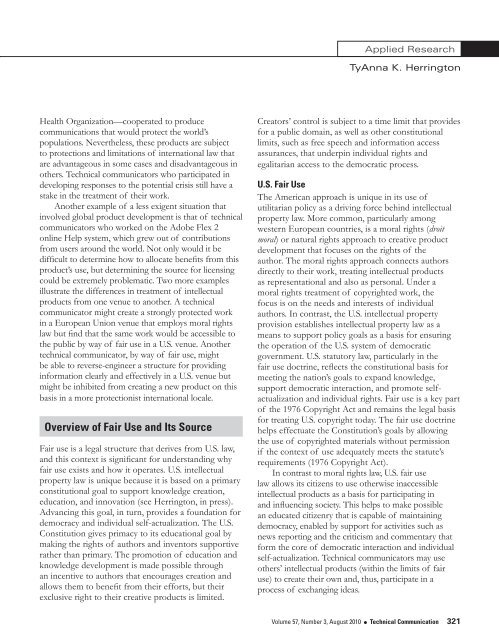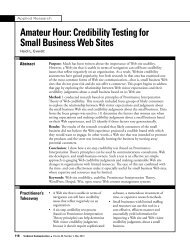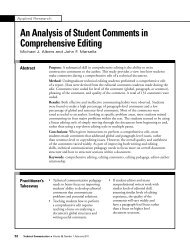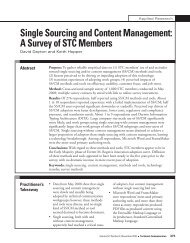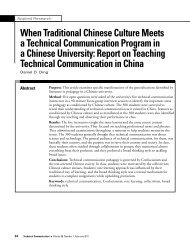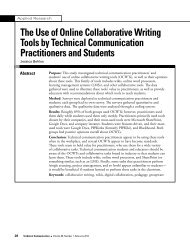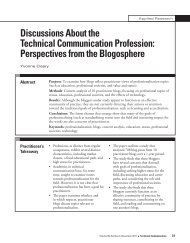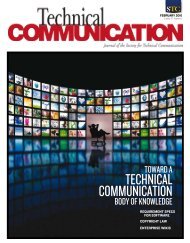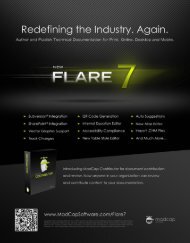Applied ResearchInternational Fair Use?be directly affected by legal developments in this area.Changes might allow greater use of all internationallyaccessible products, leading to greater innovation,but they could also mean that product creators’ ownintellectual property might not be as strictly protectedas it is under current international intellectual propertylaw. Beyond the effects on international business, allcreators should be aware of the humanistic issues thatarise in connection with the treatment of intellectualproperty, especially in international venues.In this article, I examine the position of fair use ininternational law’s treatment of intellectual property. Ianalyze fair use from the basis of U.S. law because this,rather than international law, is its source. The articlefocuses on copyright, because the fair use doctrinearises out of U.S. copyright law rather than out of otherintellectual property statutes.In this article, the term “fair use” relates to anumber of interrelated concepts. Although the termdenotes a structure for allowing use of intellectualproducts under the fair use doctrine in U.S. law, otherauthors use the same term as a conceptual signifier todiscuss the role of the fair use concept in internationallaw; thus, I also use the term in this manner. However,I want to emphasize that fair use derives from domesticU.S. law in the 1976 Copyright Act, and the processesof assessing its function and protection againstinfringement claims rely on its relationship to theprinciples laid out in the U.S. Constitution. Fair use asit exists legally in the United States does not exist ininternational intellectual property agreements.After probing the differences in how intellectualproperty law is treated domestically and ininternational law, I describe various difficultiesthat arise from the different cultural and legalperspectives. I discuss the significance of internationalparties’ diversity and suggest that signatories tointernational intellectual property agreements forgetreaties that accommodate the differing levels ofpower among international parties as a means toensure human rights to citizens of all nations. Iconclude by highlighting some of the difficulties andsuggesting areas for resolution that might lead to aform of international fair use that would satisfy allinternational parties, balancing support for innovationagainst the need to protect basic human rights.Importance of International Legal Issuesfor Technical CommunicatorsInternational legal agreements regarding intellectualproperty make clear that treaties determine howintellectual property law will be handled amonginternational parties and that anything not includedin the treaties and agreements must be decided indomestic venues on the basis of domestic law. In otherwords, neither U.S. laws nor the laws of other nationsmay determine how intellectual products are to betreated as international interests. And here lies the cruxof the problem.To suggest that a fair use doctrine should beintegrated into international intellectual propertylaw implies the incorporation of U.S. domestic law;however, the international intellectual property law thatcontrols trade in intellectual products does not allowsuch incorporation. Thus, I suggest that the humanisticconcepts of free speech and equal access be employedrather than attempting to superimpose the complex,constitutionally based structure of U.S. fair use lawon international agreements. On this basis, technicalcommunicators would be able to make empoweredand ethical choices regarding their participation ininternational product development.Many technical communicators work regularly ininternational collaborations or for clients in variouscountries, and many businesses are located in venuesoutside their home nations. For instance, the Coca-ColaCompany is well-known for its worldwide reach andeven capitalizes on it with its “World of Coca-Cola”exhibit in the Coca-Cola Museum in Atlanta, Georgia.Technical communicators have a big stake in howinternational legal issues can affect their interactionsand control what happens to their contributions,particularly in light of current challenges that may drawinternational participants together to treat issues thatignore borders. For example, communications regardingthe H1N1 virus were important at both the global andlocal levels, and information regarding the outbreak andtreatment was supplied through multiple forms. Thosewhose job it was to create communications—somecontrolled by corporations and others by nonprofitsand organizations such as the United Nations World320 Technical Communication l Volume 57, Number 3, August 2010
Applied ResearchTyAnna K. HerringtonHealth Organization—cooperated to producecommunications that would protect the world’spopulations. Nevertheless, these products are subjectto protections and limitations of international law thatare advantageous in some cases and disadvantageous inothers. Technical communicators who participated indeveloping responses to the potential crisis still have astake in the treatment of their work.Another example of a less exigent situation thatinvolved global product development is that of technicalcommunicators who worked on the Adobe Flex 2online Help system, which grew out of contributionsfrom users around the world. Not only would it bedifficult to determine how to allocate benefits from thisproduct’s use, but determining the source for licensingcould be extremely problematic. Two more examplesillustrate the differences in treatment of intellectualproducts from one venue to another. A technicalcommunicator might create a strongly protected workin a European Union venue that employs moral rightslaw but find that the same work would be accessible tothe public by way of fair use in a U.S. venue. Anothertechnical communicator, by way of fair use, mightbe able to reverse-engineer a structure for providinginformation clearly and effectively in a U.S. venue butmight be inhibited from creating a new product on thisbasis in a more protectionist international locale.Overview of Fair Use and Its SourceFair use is a legal structure that derives from U.S. law,and this context is significant for understanding whyfair use exists and how it operates. U.S. intellectualproperty law is unique because it is based on a primaryconstitutional goal to support knowledge creation,education, and innovation (see Herrington, in press).Advancing this goal, in turn, provides a foundation fordemocracy and individual self-actualization. The U.S.Constitution gives primacy to its educational goal bymaking the rights of authors and inventors supportiverather than primary. The promotion of education andknowledge development is made possible throughan incentive to authors that encourages creation andallows them to benefit from their efforts, but theirexclusive right to their creative products is limited.Creators’ control is subject to a time limit that providesfor a public domain, as well as other constitutionallimits, such as free speech and information accessassurances, that underpin individual rights andegalitarian access to the democratic process.U.S. Fair UseThe American approach is unique in its use ofutilitarian policy as a driving force behind intellectualproperty law. More common, particularly amongwestern European countries, is a moral rights (droitmoral) or natural rights approach to creative productdevelopment that focuses on the rights of theauthor. The moral rights approach connects authorsdirectly to their work, treating intellectual productsas representational and also as personal. Under amoral rights treatment of copyrighted work, thefocus is on the needs and interests of individualauthors. In contrast, the U.S. intellectual propertyprovision establishes intellectual property law as ameans to support policy goals as a basis for ensuringthe operation of the U.S. system of democraticgovernment. U.S. statutory law, particularly in thefair use doctrine, reflects the constitutional basis formeeting the nation’s goals to expand knowledge,support democratic interaction, and promote selfactualizationand individual rights. Fair use is a key partof the 1976 Copyright Act and remains the legal basisfor treating U.S. copyright today. The fair use doctrinehelps effectuate the Constitution’s goals by allowingthe use of copyrighted materials without permissionif the context of use adequately meets the statute’srequirements (1976 Copyright Act).In contrast to moral rights law, U.S. fair uselaw allows its citizens to use otherwise inaccessibleintellectual products as a basis for participating inand influencing society. This helps to make possiblean educated citizenry that is capable of maintainingdemocracy, enabled by support for activities such asnews reporting and the criticism and commentary thatform the core of democratic interaction and individualself-actualization. Technical communicators may useothers’ intellectual products (within the limits of fairuse) to create their own and, thus, participate in aprocess of exchanging ideas.Volume 57, Number 3, August 2010 l Technical Communication 321
- Page 1 and 2:
AUGUST 2010Volume 57 Number 3SPECIA
- Page 3 and 4:
PresidentMichael A. HughesVice Pres
- Page 5 and 6:
VoLuME 57, NuMBER 3AUGUST 2010ISSN
- Page 7 and 8:
Guest EditorialKirk St.Amant and Ma
- Page 9 and 10:
Applied ResearchTechnical Communica
- Page 11 and 12:
Applied ResearchNicole St. Germaine
- Page 13 and 14:
Applied ResearchNicole St. Germaine
- Page 15 and 16:
Applied ResearchNicole St. Germaine
- Page 17 and 18:
Applied ResearchNicole St. Germaine
- Page 19 and 20:
Applied ResearchNicole St. Germaine
- Page 21 and 22:
Applied ResearchNicole St. Germaine
- Page 23 and 24:
Applied ResearchNicole St. Germaine
- Page 25 and 26:
Applied TheoryTatiana BatovaIntrodu
- Page 27 and 28: Applied TheoryTatiana BatovaMoreno,
- Page 29 and 30: Applied TheoryTatiana BatovaThe Uni
- Page 31 and 32: Applied TheoryTatiana Batovadoctors
- Page 33 and 34: Applied TheoryTatiana BatovaTo addr
- Page 35 and 36: Applied TheoryTatiana Batovathe loc
- Page 37 and 38: Applied TheoryTatiana BatovaJohnson
- Page 39 and 40: Applied TheoryTatiana BatovaInterna
- Page 41 and 42: Applied TheoryMcKee and PorterIntro
- Page 43 and 44: Applied TheoryMcKee and PorterFor e
- Page 45 and 46: Applied TheoryMcKee and Porterpubli
- Page 47 and 48: Applied TheoryMcKee and PorterBecau
- Page 49 and 50: Applied TheoryMcKee and Porterof th
- Page 51 and 52: Applied TheoryMcKee and Porterwith
- Page 53 and 54: Applied TheoryMcKee and PorterA Cop
- Page 55 and 56: Applied TheoryMcKee and PorterConte
- Page 57 and 58: Applied TheoryMcKee and PorterWalto
- Page 59 and 60: Applied ResearchLiza PottsIntroduct
- Page 61 and 62: Applied ResearchLiza Pottsdoes not
- Page 63 and 64: Applied ResearchLiza PottsUser’s
- Page 65 and 66: Applied ResearchLiza Pottsactors, t
- Page 67 and 68: Applied ResearchLiza PottsDRM has a
- Page 69 and 70: Applied ResearchLiza Pottsmake bett
- Page 71 and 72: Applied ResearchLiza PottsOne viewe
- Page 73 and 74: Applied ResearchLiza Pottsinvolved
- Page 75 and 76: Applied ResearchLiza PottsHayhoe, G
- Page 77: Applied ResearchInternational Fair
- Page 81 and 82: Applied ResearchTyAnna K. Herringto
- Page 83 and 84: Applied ResearchTyAnna K. Herringto
- Page 85 and 86: Applied ResearchTyAnna K. Herringto
- Page 87 and 88: Applied ResearchTyAnna K. Herringto
- Page 89 and 90: Book ReviewsWriting Successful Scie
- Page 91 and 92: Book ReviewsThe Process: Business P
- Page 93 and 94: Book ReviewsHCI Beyond the GUI: Des
- Page 95 and 96: Book ReviewsOrigins of the Specious
- Page 97 and 98: Book Reviewsgenre, and process, top
- Page 99 and 100: Book ReviewsPart One goes from the
- Page 101 and 102: Book Reviewsrather than writers, an
- Page 103 and 104: Book ReviewsHow to Write Fast Under
- Page 105 and 106: Book Reviewsmanagement system (CMS)
- Page 107 and 108: Book Reviewsnearly strangled when h
- Page 109 and 110: Book Reviewsinteractive TV model)
- Page 111 and 112: Book ReviewsOtherwise, Beech shows
- Page 113 and 114: Book Reviewssuch as blog, I found m
- Page 115 and 116: Book Reviewsemployees and effective
- Page 117 and 118: Recent & RelevantSherry Southard, E
- Page 119 and 120: Recent & RelevantRecent & RelevantC
- Page 121 and 122: Recent & RelevantRecent & RelevantE
- Page 123 and 124: Recent & Relevantworking in a langu
- Page 125 and 126: Recent & RelevantWhat’s the big d
- Page 127 and 128: Recent & RelevantScientific Writing
- Page 129 and 130:
Recent & Relevantapplicability. Man
- Page 131:
Did You Missthe Summit?Don’t miss


